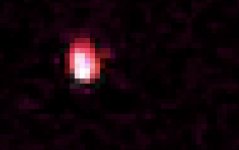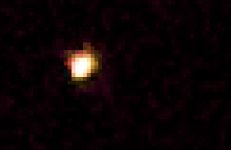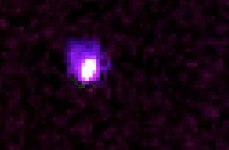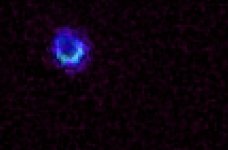Back to my thesis about 4 letters and a B.
Born, Bohm, Bose, Bell, Buti, Boas, Biot and Bohr.
Tell me if there's any more.
Walter Boas was a principal research officer in the field of Tribophysics until someone rubbed him up the wrong way! 😀
EDIT: Here's Olivia getting physical with me (I've lost weight since!):
Last edited:
In fact, the Physicist's favourite pop star is Cher.

Anti-matter discoverer Paul Dirac liked her to the point of near-obsession in his dotage, and even bought a television so he could watch her, along with Sting and Elton John.
Presumably while his wife was elsewhere, if he had any sense.
I will have more to say about the mighty Dirac later. There is a plaque to him and his equation in Westminster Abbey, which I am sure you have all visited on the extended "Dirac Trail".
With the recent complete disappointment served nightly by putative Nova T CrB, I have been scratching round for any other interest in my allegedly dark snaps:

Recall that the allegedly expected Nova location is marked with a red circle:

You are doubtless wondering what the star in the bottom left is called. It is, in fact, Pi Serpentis.
Thus we can say with confidence and some precision, if asked, that the Nova is expected near a line between Pi Serpentis and Epsilon Corona Borealis.
Which form an Isosceles triangle with Delta Corona Borealis. And the Nova may form a Pythagorean triangle with Epsilon and Delta, with as yet uncalculated integer values. Strange but true.
Anti-matter discoverer Paul Dirac liked her to the point of near-obsession in his dotage, and even bought a television so he could watch her, along with Sting and Elton John.
Presumably while his wife was elsewhere, if he had any sense.
I will have more to say about the mighty Dirac later. There is a plaque to him and his equation in Westminster Abbey, which I am sure you have all visited on the extended "Dirac Trail".
With the recent complete disappointment served nightly by putative Nova T CrB, I have been scratching round for any other interest in my allegedly dark snaps:
Recall that the allegedly expected Nova location is marked with a red circle:
You are doubtless wondering what the star in the bottom left is called. It is, in fact, Pi Serpentis.
Thus we can say with confidence and some precision, if asked, that the Nova is expected near a line between Pi Serpentis and Epsilon Corona Borealis.
Which form an Isosceles triangle with Delta Corona Borealis. And the Nova may form a Pythagorean triangle with Epsilon and Delta, with as yet uncalculated integer values. Strange but true.
Last edited:
Anti-matter discoverer Paul Dirac...
Here is Paul Dirac's "beautiful" equation inscribed on his commemorative marker at Westminster Abbey:
I was interested and somewhat surprised to learn that the principle of mathematical beauty became almost a religion to Dirac.
He believed theoretical physicists should be guided by mathematical beauty rather than whether their theories agreed with the latest experimental data.
P.S. For what it's worth, Dirac was also a fan of Mickey Mouse!
I have to admit that rediscovering Paul Dirac is a breath of fresh air in the confusion that is modern Physics.
I have related how I learned of the Dirac equation of the Electron, amazingly compressed onto the back of a beermat, many years back in The Duke of Devonshire Pub in Marloes Road from a student of David Bohm.
Whilst the sound is largely restored, the blackboard work is sadly a complete smudge, I suppose I imagined it right whilst I lulled off to sleep last night purely listening to the great man.
Dirac was politely scathing about Schrodinger. But admitted that Heisenberg, whilst right, may be superceded by a better theory in the future. Feynman's "Ugly" QED got it both barrels from him. QFT fared little better.
His advice to young maths genius Ed Witten was to pursue a career in anything but Quantum Field Theory.
Whether String Theory was a wise subsequent choice must be left for posterity to decide.

What does this mean? This means that my Schrodinger Tee Shirt is for the bin along with his indeterminate cat:


So far, so good on my Heisenberg Tee Shirt:


Now I must get back to my Heisenberg book. Lot to get through here.
Best from Steve, probably in Portsmouth, UK.
I have related how I learned of the Dirac equation of the Electron, amazingly compressed onto the back of a beermat, many years back in The Duke of Devonshire Pub in Marloes Road from a student of David Bohm.
Whilst the sound is largely restored, the blackboard work is sadly a complete smudge, I suppose I imagined it right whilst I lulled off to sleep last night purely listening to the great man.
Dirac was politely scathing about Schrodinger. But admitted that Heisenberg, whilst right, may be superceded by a better theory in the future. Feynman's "Ugly" QED got it both barrels from him. QFT fared little better.
His advice to young maths genius Ed Witten was to pursue a career in anything but Quantum Field Theory.
Whether String Theory was a wise subsequent choice must be left for posterity to decide.
What does this mean? This means that my Schrodinger Tee Shirt is for the bin along with his indeterminate cat:
So far, so good on my Heisenberg Tee Shirt:
Now I must get back to my Heisenberg book. Lot to get through here.
Best from Steve, probably in Portsmouth, UK.
I wonder if it'll be like this Pythagorean triangle.Which form an Isosceles triangle with Delta Corona Borealis. And the Nova may form a Pythagorean triangle with Epsilon and Delta, with as yet uncalculated integer values. Strange but true.
No, it’s just going to make its appearance the next time it’s cloudy and raining for a month.
Very cloudy skies tonight, but I got a sufficiently good snap to confirm no Nova. It's also getting lower in the sky and nearer the sunset as autumn nears, which is a worry.
Have been mulling over the surprising conundrum of applying Pythagoras' Theorem with complex numbers.
This is an abuse or extension of Pythagoras' Theorem, of course, which was originally formulated for positive numbers or integers.
If you were drawing 1 + i or 1 - i as a complex number in an Argand diagram, you would get a modulus of SQRT 2, and an argument of +/- Pi/4 or 45 degrees.
You could also express it as SQRT 2 x EXP(i x Pi/4) or SQRT 2 x EXP(-i x Pi/4) as Euler famously discovered. Engineers use j instead of i, as it goes, which I usually do too by habit.
But we are getting 0 here. Where have we seen this sort of thing before?

So the complex value corresponds to a time ict, and the real value is just spatial x in a simplified Minkowski Spacetime diagram.
Pythagoras is a Spatial relation in Classical Galilean Relativity around a circle:

Our new one can be interpreted as Einsteinian Special Relativity which works with Hyperbolas:

This leads to those baffling light cones:

https://en.wikipedia.org/wiki/Light_cone
I think I'll stop there, while I am ahead. 🤣
Have been mulling over the surprising conundrum of applying Pythagoras' Theorem with complex numbers.
This is an abuse or extension of Pythagoras' Theorem, of course, which was originally formulated for positive numbers or integers.
If you were drawing 1 + i or 1 - i as a complex number in an Argand diagram, you would get a modulus of SQRT 2, and an argument of +/- Pi/4 or 45 degrees.
You could also express it as SQRT 2 x EXP(i x Pi/4) or SQRT 2 x EXP(-i x Pi/4) as Euler famously discovered. Engineers use j instead of i, as it goes, which I usually do too by habit.
But we are getting 0 here. Where have we seen this sort of thing before?
So the complex value corresponds to a time ict, and the real value is just spatial x in a simplified Minkowski Spacetime diagram.
Pythagoras is a Spatial relation in Classical Galilean Relativity around a circle:
Our new one can be interpreted as Einsteinian Special Relativity which works with Hyperbolas:
This leads to those baffling light cones:
https://en.wikipedia.org/wiki/Light_cone
I think I'll stop there, while I am ahead. 🤣
Last edited:
So the complex value corresponds to a time ict
I googled to find out where the term "ict" comes in. 🤓
Minkowski proposed that the space-time interval, s, is related to space and time by Pythagoras' theorem in four dimensions:

Where i is the imaginary unit

In the above equation, the 'second' becomes just another unit of length.
Now


Minkowski's use of the imaginary unit has been superseded by the use of the "metric tensor".
I extracted the information from this source: https://en.wikibooks.org/wiki/Special_Relativity/Spacetime#:~:text=He proposed that the space-time interval might be,time interval spanned by the space-time interval, s.
At 00.30 I pointed my 300mm towards NNE 30 deg (?), positioned in Stockholm, I caught these. A thing on the dark sky catches my attention as it seemed to flicker in color so I opted for a try to document it... Its one and the same object but with somewhat of a sloppy post processing... Of course it was small... What was it?

//
//
Attachments
What was it?
The colours are likely due to chromatic aberration caused by the camera lens system.
This is normally seen as a blue halo around a poorly focused astronomical object such as a planet.
I think Rabbit's relative, Small, may have been on your camera lens.
Can you spot him here?

Beetles are often kind of irridescent, which explains your pictures I think.
More prosaicly, one has to wonder if you were looking at bright Capella.

This is the Night Sky for midnight July 1st in Greenwich, London by convention here. I leave you to adjust for your latitude near the North Pole, and time of month.
Yes, my money (other than that reserved for "Notable Speech" in the Sussex Stakes this afternoon at Goodwood) is on you having observed sparkling Capella low in the city haze of Stockholm. But this is the merest guess. 🙂
Can you spot him here?
Beetles are often kind of irridescent, which explains your pictures I think.
More prosaicly, one has to wonder if you were looking at bright Capella.
This is the Night Sky for midnight July 1st in Greenwich, London by convention here. I leave you to adjust for your latitude near the North Pole, and time of month.
Yes, my money (other than that reserved for "Notable Speech" in the Sussex Stakes this afternoon at Goodwood) is on you having observed sparkling Capella low in the city haze of Stockholm. But this is the merest guess. 🙂
Last edited:
This I saw first with my own eyes and was also in the pictures. The colours as I saw them made me take the pictures. This was taken with a Canon 7d2 and an EF-300/4,0 L IS. The lens has some purple fringing at times but only in bright reflections - no such thing here 🙂The colours are likely due to chromatic aberration caused by the camera lens system.
//
Steve mentioned Capella.
I read that when a bright star such as Capella is close to the horizon it can be seen to twinkle and flash in different colours.
The starlight has to travel through a thick layer of atmosphere when the star is low in the sky, and on its way it encounters pockets of air of different temperatures and densities.
These air pockets refract the different colours in the starlight at different angles so the star appears to randomly change brightness and colour.
It's either that or:

"Spaceship" UFO changes colour in INCREDIBLE footage - Daily Star
👽
I read that when a bright star such as Capella is close to the horizon it can be seen to twinkle and flash in different colours.
The starlight has to travel through a thick layer of atmosphere when the star is low in the sky, and on its way it encounters pockets of air of different temperatures and densities.
These air pockets refract the different colours in the starlight at different angles so the star appears to randomly change brightness and colour.
It's either that or:
"Spaceship" UFO changes colour in INCREDIBLE footage - Daily Star
👽
At 00.30 I pointed my 300mm towards NNE 30 deg (?), positioned in Stockholm, I caught these. A thing on the dark sky catches my attention as it seemed to flicker in color so I opted for a try to document it... Its one and the same object but with somewhat of a sloppy post processing... Of course it was small... ...snip
Exactly what I was saying all along... 🤣
The alternative Capella theory is reinforced by my list of bright stars:
I didn't know this, but Alpha Centauri is an easily resolved double varying between 2 and 22 arcseconds over 80 years. Well within the capability of binoculars or even my cheap Nikon DSLR camera and tripod.
Alas a Southern Sky object.
Traditionally we say that stars twinkle and planets don't.
My advice tonight is to repeat the observation, perhaps with a wider field lens to give a context of other nearby stars. This is what PROFESSIONALS do. We shall soon solve the mystery.
Now I must go and study the fillies' form for Ladies' Day at Goodwood tomorrow, after today's notable triumph in the Sussex Stakes with "Notable Speech" at a tasty 3-1. Followed by more Nova hunting.
- Home
- Member Areas
- The Lounge
- Does this explain what generates gravity?



